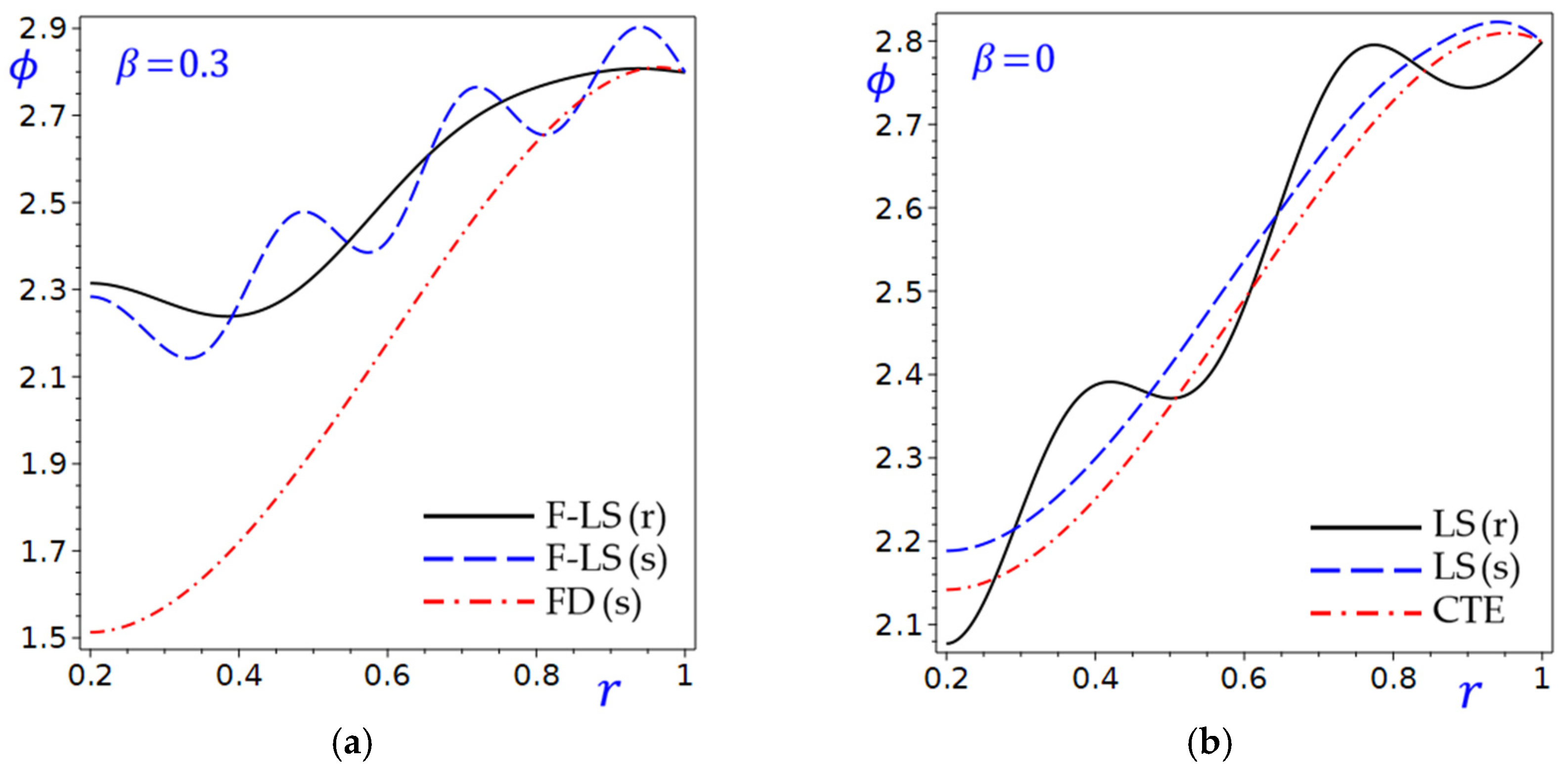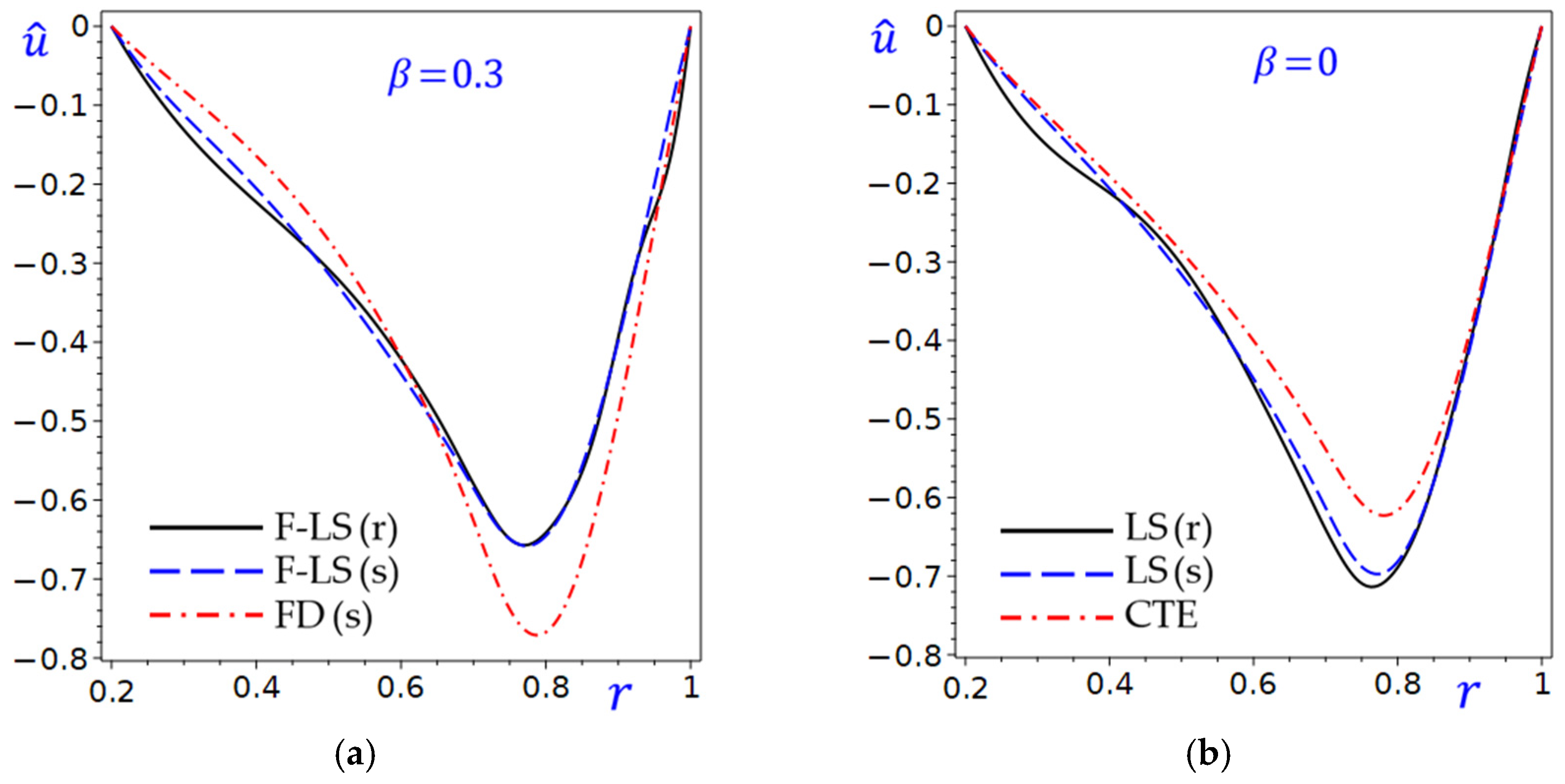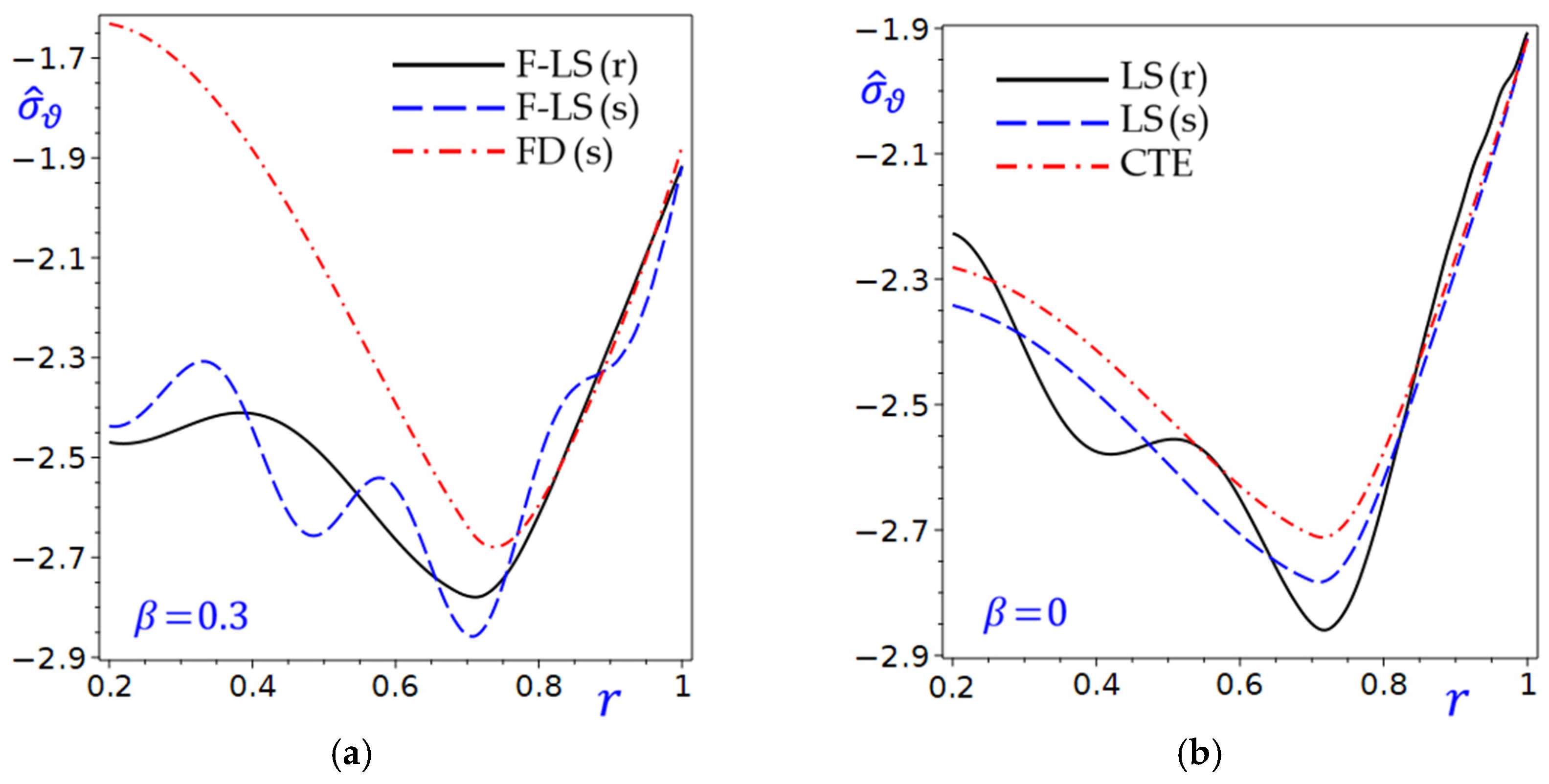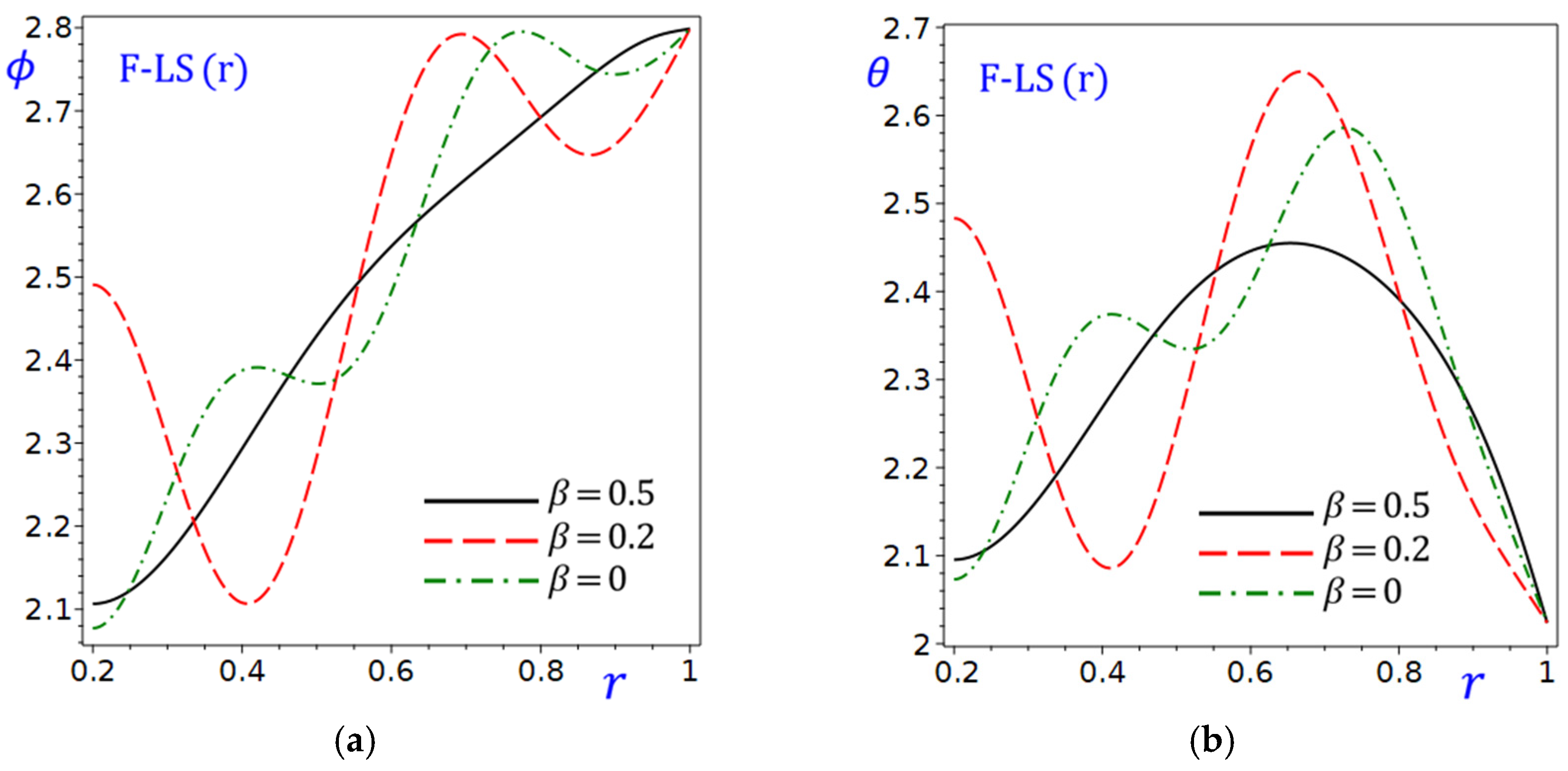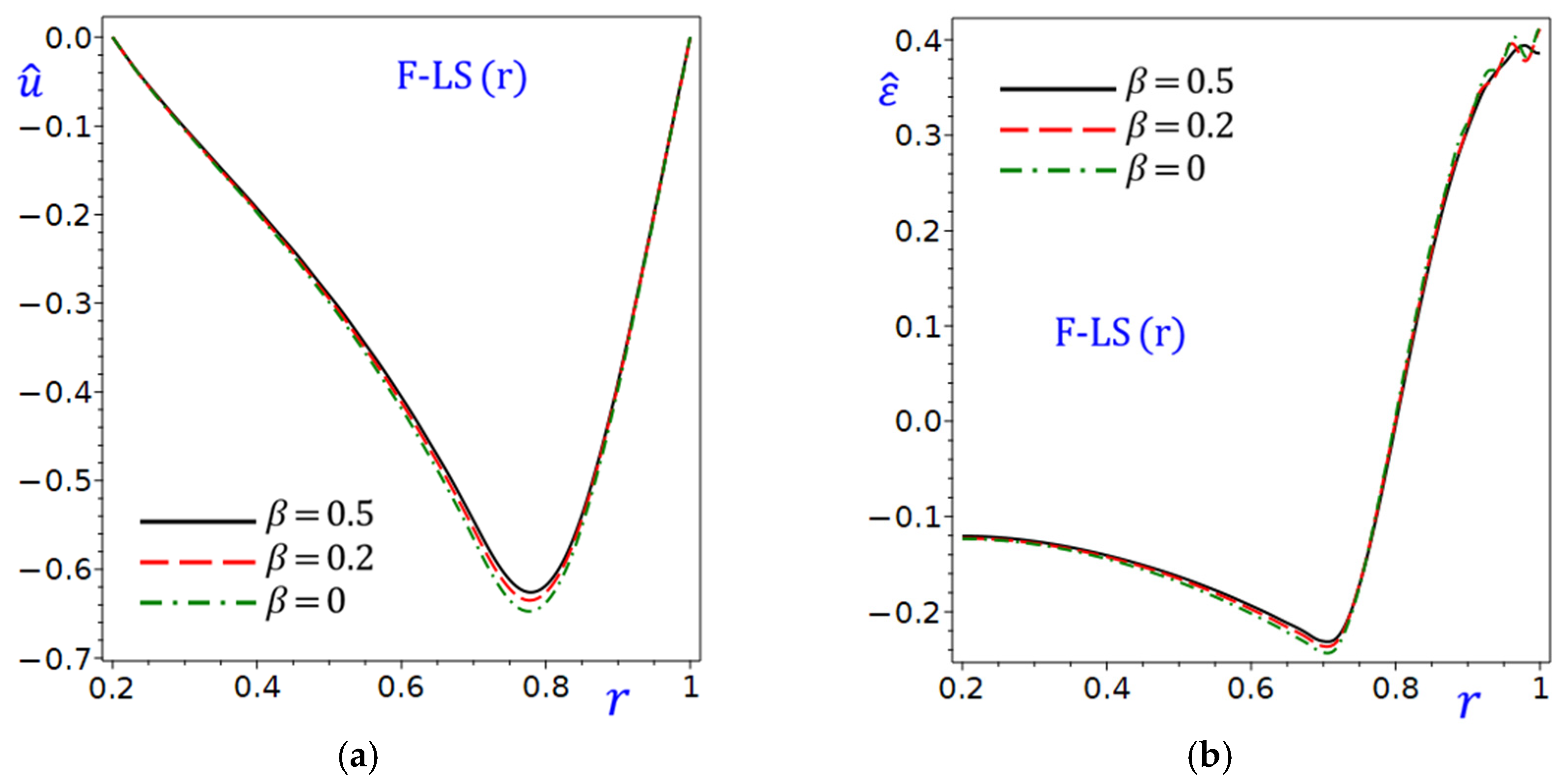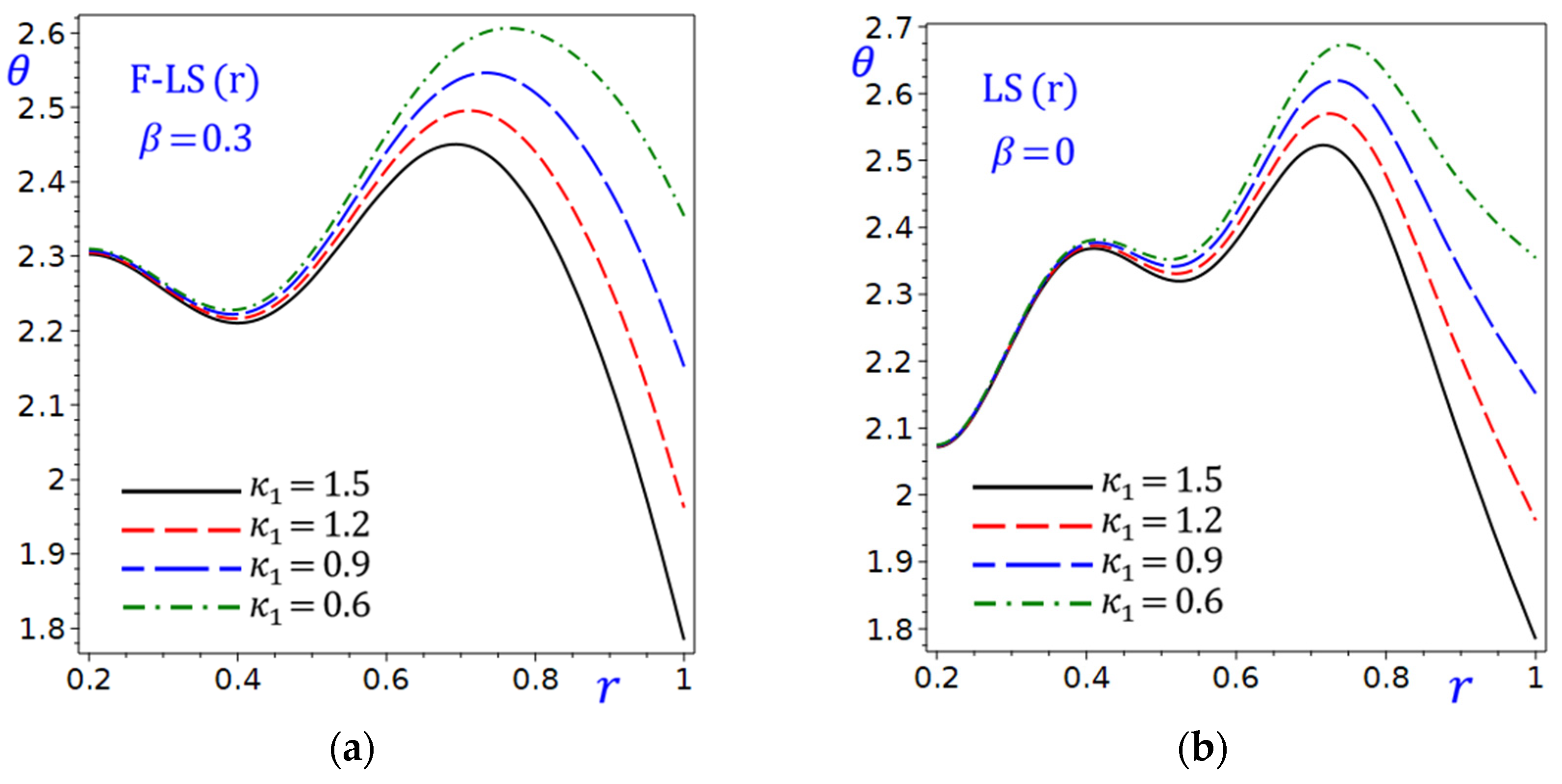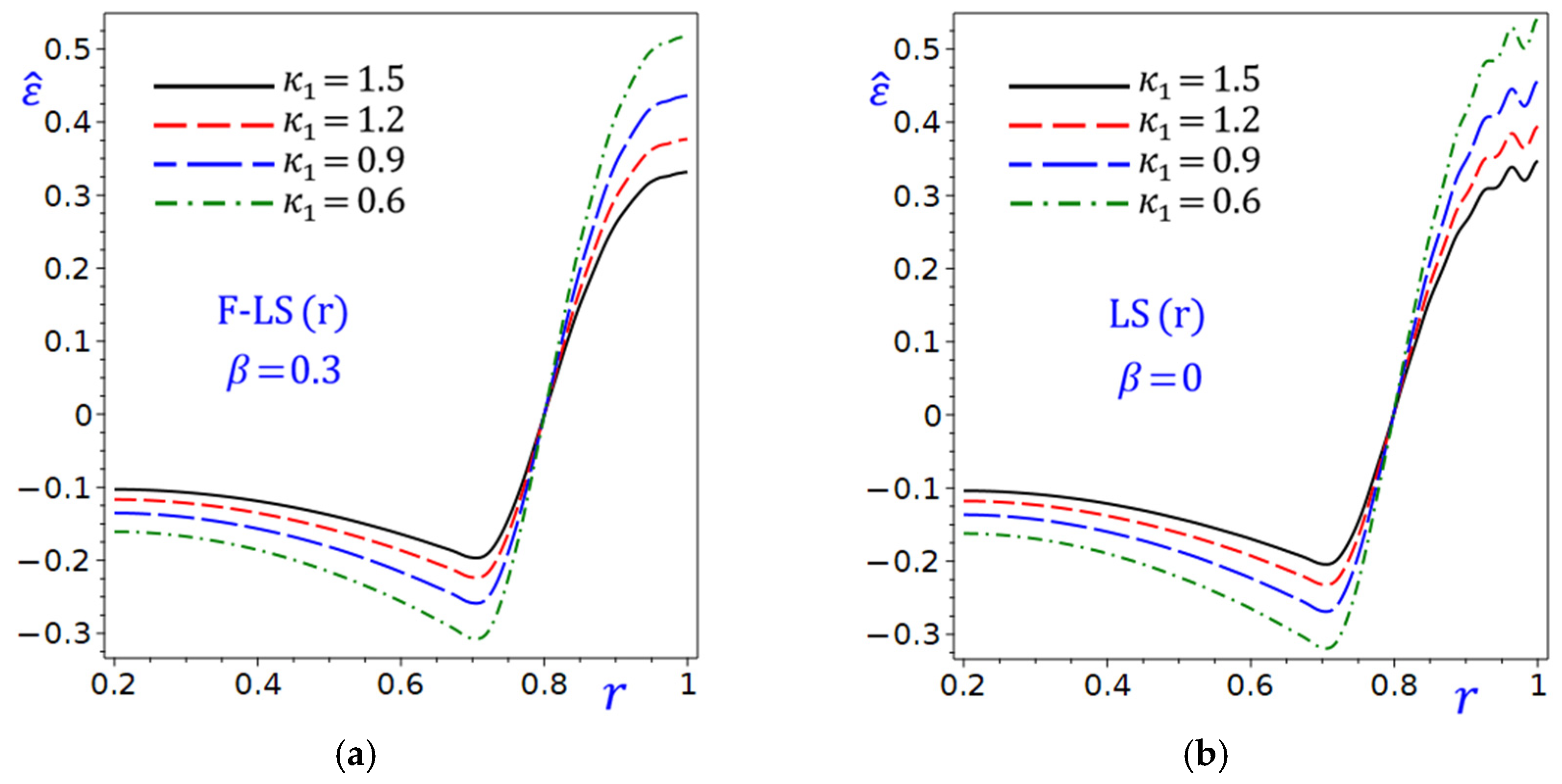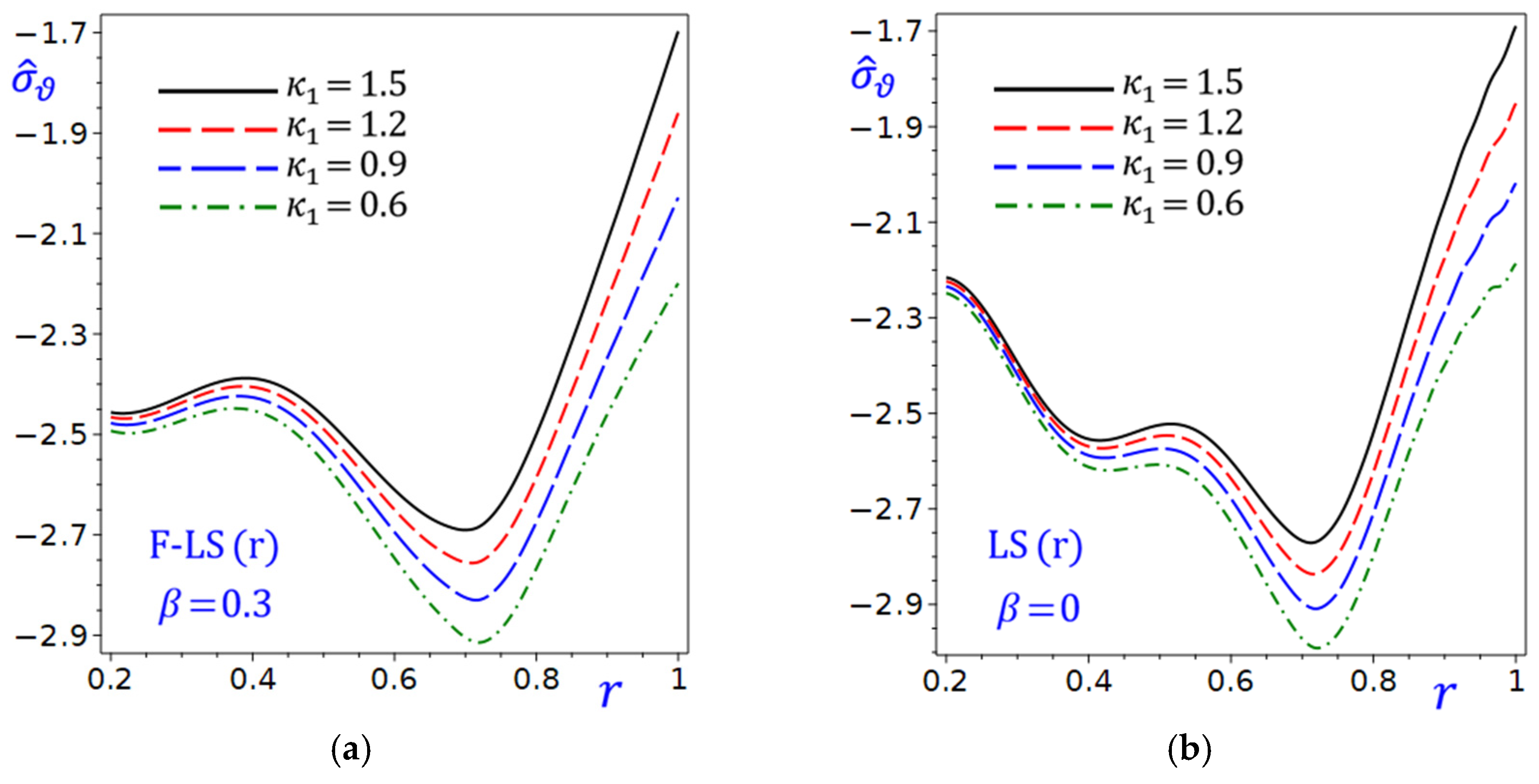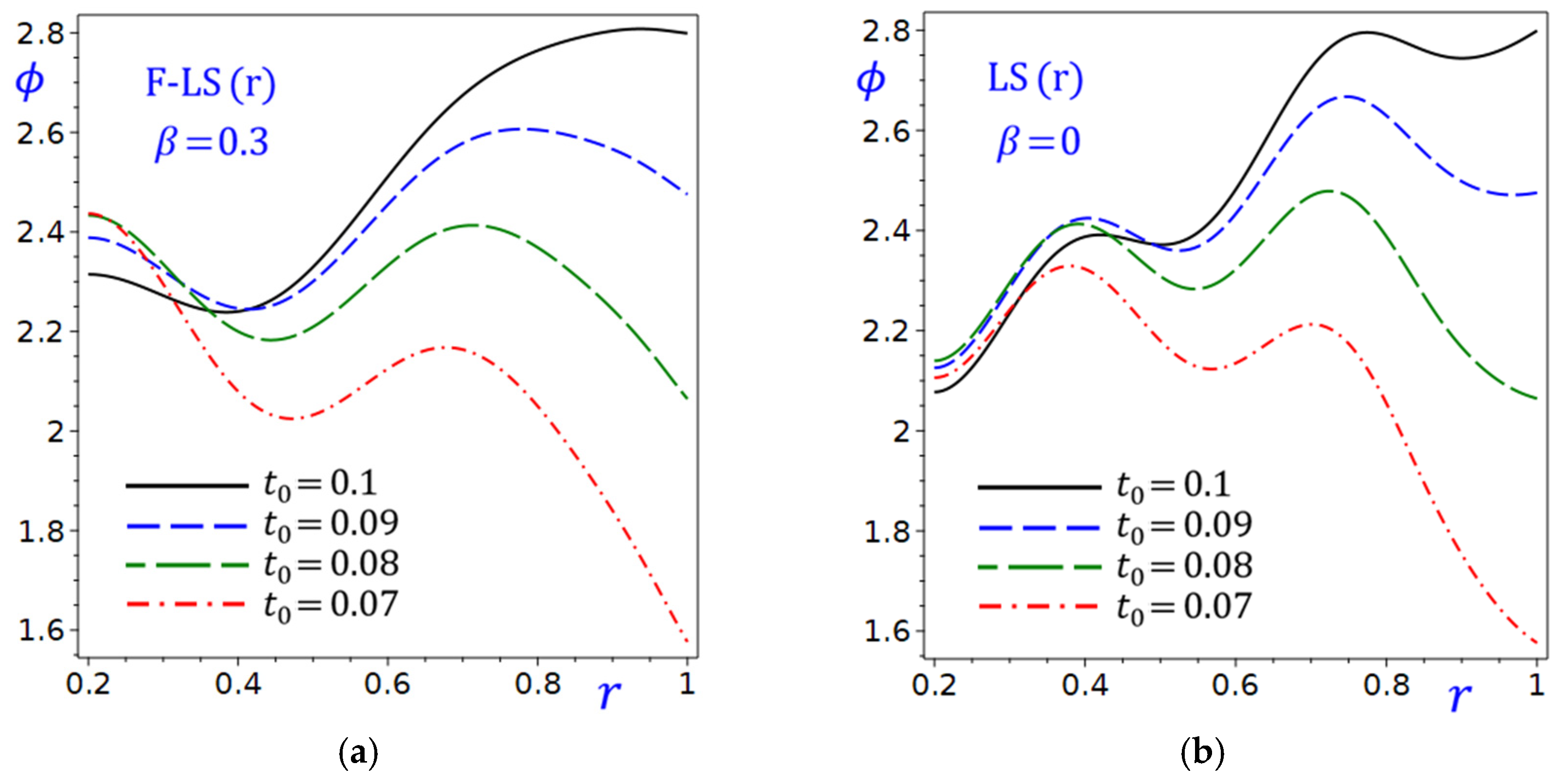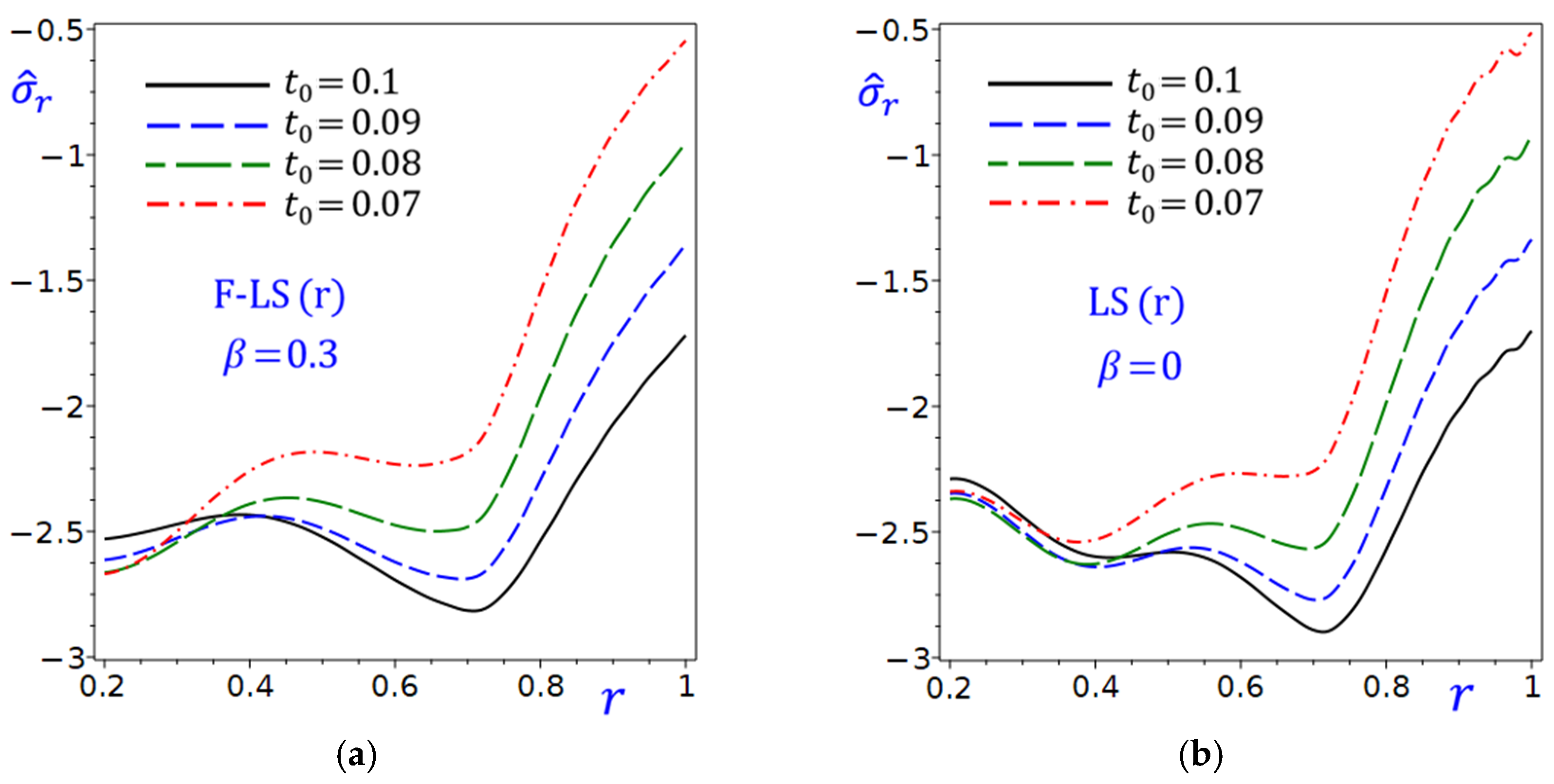4.1. Comparison Between Various Theories
The graphs in
Figure 2 compare the temperature-mapping
for the circular cylinder under two scenarios: with (
) and without (
) the fraction parameter. The curves in
Figure 2a show how
varies with
for
, with F-LS (r) exhibiting the highest values. However, the curves in
Figure 2b are closer together compared to
Figure 2a, indicating less variation in
when
. The inclusion of
in graph (a) leads to a wider range of
values and distinct separation between theories, while its absence in graph (b) results in more clustered curves. All theories (F-LS, FD, LS, CTE) are used to investigate the temperature-mapping distribution, with differences in their predictions highlighted.
Figure 2.
The temperature-mapping of the circular cylinder with and without the fraction parameter: (a) ; (b) .
Figure 2.
The temperature-mapping of the circular cylinder with and without the fraction parameter: (a) ; (b) .
Figure 3 depicts the relationship between the temperature
and
on the horizontal axis under different conditions. In
Figure 3a, all curves show an increasing trend in
as
increases from 0.2 to 0.8. The curve of refined fractional F-LS (r) theory starts highest (
at
) and decreases sharply. The curves of the simple fraction F-LS (s) and FD (s) theories start lower and decline more gradually. The gap between F-LS (r) and the other two curves narrows as
increases. In
Figure 3b, all curves show an increasing trend in
as
increases from 0.2 to 0.75. The curve of
due to the refined LS (r) theory starts lowest (
at
) and increases rapidly. The temperature due to the LS (s) and CTE theories starts higher and declines more gradually. The gap between
due to the refined LS (r) theory and the other two theories narrows as
increases. In both plots,
is no longer increasing and decreasing again, with its maximum occurring at
. The rate of decrease is steeper for curves due to the refined theories compared to the simple or other theories.
Figure 3a (
) shows higher initial
values compared to
Figure 3b with
, suggesting
influences the baseline
. The refined F-LS (r) or LS (r) theories consistently yield higher
values at lower
but converge with other theories as
increases. The CTE and FD (s) theories exhibit more stable or gradual declines in temperature.
Figure 3.
The temperature of the circular cylinder with and without the fraction parameter: (a) ; (b) .
Figure 3.
The temperature of the circular cylinder with and without the fraction parameter: (a) ; (b) .
Figure 4 shows the radial displacement
of the circular cylinder with and without the fraction parameter (a)
(b)
. In
Figure 4a, the curves show how the radial displacement changes along the radial direction of the cylinder with
. The fractional F-LS and FD theories are compared, with one likely being a benchmark. The F-LS (r) and FD (s) theories may converge or diverge as
increases. The curves in
Figure 4b may show how the generalized and classical theories perform under
, with the CTE theory potentially serving as a theoretical or ideal case. The LS (r) and CTE theories might represent bounds or benchmarks for LS (s) theory. Generally, both plots explore the effect of
, with
fixed at 0.3 in
Figure 4a and 0 in
Figure 4b. This suggests
modulates the radial displacement
of the cylinder’s behavior.
Figure 4.
The radial displacement of the circular cylinder with and without the fraction parameter: (a) ; (b) .
Figure 4.
The radial displacement of the circular cylinder with and without the fraction parameter: (a) ; (b) .
Figure 5 shows the dilatation
of the circular cylinder with (
) and without (
) the fraction parameter. All curves in
Figure 5a start near
at
. As
increases,
rises sharply for the fractional F-LS (r) and F-LS (s) theories, peaking around
before declining. The FD (s) theory shows a more gradual increase, peaking later (around
) and remaining positive for higher
values. The plot highlights how
is sensitive to
, with theory-dependent variations. Also, all curves in
Figure 5b start near
at
. The LS (s) and CTE theories show similar trends, declining to a peak around
before rising. The plot demonstrates how
leads to smaller
magnitudes compared to
as in
Figure 5a. In general, both plots show that
is highly dependent on
, with peaks at
. Different theories yield varying
trends, highlighting the importance of theory selection in analysis. The contrast between
in
Figure 5a and
in
Figure 5b suggests that
influences the magnitude and shape of
curves.
Figure 5.
The dilatation of the circular cylinder with and without the fraction parameter: (a) ; (b) .
Figure 5.
The dilatation of the circular cylinder with and without the fraction parameter: (a) ; (b) .
Figure 6 depicts the relationship between radial stress
of the circular cylinder and the radial direction
for different theories or conditions. All theories in
Figure 6a show a decreasing trend in
as
increases. The curves of
may converge or diverge depending on
, suggesting varying performance or sensitivity of the theories under different conditions. In
Figure 6b, the trend of
decreasing with
persists, but the behavior of the theories may differ due to
. The inclusion of
provides additional insight into the asymptotic behavior of
. In fact, comparing
Figure 6a,b shows how the parameter
influences the relationship between
and
. The differences in trends suggest
plays a significant role in the cylinder’s behavior.
Figure 6.
The radial stress in the circular cylinder with and without the fraction parameter: (a) ; (b) .
Figure 6.
The radial stress in the circular cylinder with and without the fraction parameter: (a) ; (b) .
Figure 7 shows the hoop stress
of the circular cylinder with and without the fraction parameter (a)
(b)
. The performance of all theories in
Figure 7a degrades (values of
become more negative) as
increases. The F-LS (r) and F-LS (s) theories may overlap or perform similarly, while the FD (s) theory shows a different trend, possibly worse performance of
at higher
. The refined and simple F-LS theories may outperform the FD (s) theory at higher
. In
Figure 7b, all theories show a decline in performance (more negative values of
) as
increases. The CTE theory appears to perform
worse than LS (r) and LS (s) theories across most
values. The LS(r) theory outperforms the CTE and LS (s) theories, with variants possibly being similar. Increasing
negatively impacts performance in both plots, suggesting it may control a trade-off. The difference between plots suggests
influences the behavior of the theories. For example,
may lead to better performance for F-LS theories in
Figure 7a compared to
in
Figure 7b.
Figure 7.
The hoop stress in the circular cylinder with and without the fraction parameter: (a) ; (b) .
Figure 7.
The hoop stress in the circular cylinder with and without the fraction parameter: (a) ; (b) .
4.2. Effect of Fractional Parameter
Figure 8a shows the effect of the fractional parameter
of the circular cylinder on the temperature-mapping
due to the refined F-LS (r) theory.
Figure 8.
Effect of fractional parameter of the circular cylinder due to the refined F-LS (r) theory: (a) temperature-mapping ; (b) temperature .
Figure 8.
Effect of fractional parameter of the circular cylinder due to the refined F-LS (r) theory: (a) temperature-mapping ; (b) temperature .
The figure involves the fractional parameter
with values 0.5, 0.2, and 0. The curve of
for
is the increasing function of
The curve for
starts at the highest value of
(around 2.5) and decreases sharply as
increases, peaking around
then increases rapidly as
increases, peaking once again around
then decreases as
increases with a third peaking around
. The curve of
for
may be similar to that for
.
Figure 8b shows the effect of the fractional parameter
of the circular cylinder on the temperature
due to the refined F-LS (r) theory. The curve for
starts at the highest value of
(around 2.5) and decreases sharply as
increases, peaking around
then increases rapidly as
increases, peaking once again around
. The curves for
and
start at a lower value (around 2.1) and increase more gradually. In general,
Figure 8 illustrates how the temperature-mapping
and the temperature
vary with
for different
values due to the refined F-LS (r) theory. The figure highlights the role of
in determining the sensitivity of
and
to changes in
. The trends suggest that careful selection of
is crucial for optimizing the performance or output represented by
and
due to the refined F-LS (r) theory.
Figure 9a shows the effect of the fractional parameter
of the circular cylinder on displacement
due to the refined F-LS (r) theory. For all
values (0, 0.2, 0.5),
due to the F-LS (r) theory decreases (becomes more negative) as
increases. The rate of decrease is more pronounced for higher
values. For example,
shows a steeper decline of
compared to
. At
, the displacement
reaches its lowest value, with
yielding the most negative result.
Figure 9b shows the effect of the fractional parameter
of the circular cylinder on the dilatation
due to the refined F-LS (r) theory. For
,
remains relatively stable or slightly decreases as
increases. For
and
,
decreases more significantly as
increases, with
showing the steepest decline. At
,
becomes negative for all
, indicating a potential over-correction or instability in the cylinder. In general, higher
values lead to more pronounced changes in both
and
as
increases. This suggests that
amplifies the sensitivity of these metrics to
. Increasing
generally leads to a decrease in both
and
, with the effect being more dramatic for larger
values.
Figure 9.
Effect of fractional parameter of the circular cylinder due to the refined F-LS (r) theory: (a) displacement ; (b) dilatation .
Figure 9.
Effect of fractional parameter of the circular cylinder due to the refined F-LS (r) theory: (a) displacement ; (b) dilatation .
Figure 10 shows the effect of the fractional parameter
on the radial
and hoop
stresses of the circular cylinder due to the refined F-LS (r) theory. The radial stress
in
Figure 10a ranges is approximately
to
. For all
values,
becomes more negative (i.e., compressive stress increases) as
increases. Higher
values (e.g.,
) result in less compressive
compared to lower
values (e.g.,
). The curves are smooth and monotonically decreasing, suggesting a consistent radial stress gradient. The hoop stress
in
Figure 10b shows similar curves to
Figure 10a,
becomes more compressive as
increases. Higher
values lead to less compressive hoop stresses, with
showing the least compressive behavior. The curves are smooth and exhibit a consistent gradient, though the drop is steeper compared to
. In general, the fractional parameter
reduces compressive stresses in both radial and hoop directions as it increases. The trend suggests
may correlate with stiffness or a non-dimensional load parameter. Both
and
are compressive (negative) across the domain, typical of confined or pressurized structures. The hoop stresses
are generally more compressive than radial stresses
.
Figure 10.
Effect of fractional parameter of the circular cylinder due to the refined F-LS (r) theory: (a) radial stress ; (b) hoop stress .
Figure 10.
Effect of fractional parameter of the circular cylinder due to the refined F-LS (r) theory: (a) radial stress ; (b) hoop stress .
4.3. Effect of Thermal Conductivity Parameter
Figure 11 depicts the relationship between the temperature
and the radial direction of the cylinder
for different values of the thermal conductivity parameter
under two distinct conditions: F-LS (r) theory with
in
Figure 11a and LS (r) theory with
in
Figure 11b.
Figure 11.
Effect of thermal conductivity parameter on the temperature of the circular cylinder due to the refined: (a) F-LS (r); (b) LS (r) theories.
Figure 11.
Effect of thermal conductivity parameter on the temperature of the circular cylinder due to the refined: (a) F-LS (r); (b) LS (r) theories.
In both plots,
decreases as
increases, indicating an inverse relationship between the two variables. The rate of decrease in
is more pronounced at lower values of
and tends to stabilize as
approaches 1. Higher values of the thermal conductivity parameter
(e.g., 1.5) result in lower
values across all
, while lower values of
(e.g., 0.6) lead to higher
values. This suggests that
non-positively influences
. The separation between curves for different
values is consistent, indicating that the effect of
on
is uniform across the range of
. In
Figure 11b, the temperature
values are generally higher compared to those in
Figure 11a for all values of
values. This implies that the presence of
in the F-LS (r) theory increases
.
In
Figure 12, the effects of the thermal conductivity parameter
on the radial displacement
of the circular cylinder due to the refined F-LS (r) and LS (r) theories are presented. In
Figure 12a, four curves are plotted for different values of
: 1.5, 1.2, 0.9, and 0.6. All curves start near
and decrease monotonically as
increases. Higher
values (e.g., 1.5) result in a slower decline, while lower
values (e.g., 0.6) lead to a steeper drop. The negative slope of
suggests that increasing
reduces the response
. The effect is more pronounced for smaller
, indicating that
modulates the sensitivity of
to
. In
Figure 12b, the plot of
due to the LS (r) theory with
is considered. All curves of
start at 0 and decrease as
increases. Higher
values again result in a gentler decline, while lower
values cause a sharper drop.
Figure 12.
Effect of thermal conductivity parameter on the radial displacement of the circular cylinder due to the refined: (a) F-LS (r); (b) LS (r) theories.
Figure 12.
Effect of thermal conductivity parameter on the radial displacement of the circular cylinder due to the refined: (a) F-LS (r); (b) LS (r) theories.
Figure 13 shows the effect of the thermal conductivity parameter
on the dilatation
of the circular cylinder due to the refined F-LS (r) and LS (r) theories. Both plots show
decreasing as
increases, indicating that
leads to reduced dilatation. At
, the dilatation vanishes irrespective of the value of the thermal conductivity parameter
. The curves for different
values are distinct, suggesting that
significantly influences the dilatation behavior. Higher
values (e.g., 1.5) result in higher
values in
and lower
values in
. This implies that
is not directly proportional to the dilatation measure. In
Figure 13a, the curves exhibit the same pronounced decrease in
with increasing
as in
Figure 13b, indicating that the presence of
has little sensitivity to the variation of
. For
close to 0,
is at its local highest, and the difference between curves for varying
is most noticeable. As
approaches 0.8,
trends toward zero or a minimal value, with the curves converging. The maximum values of
occur at the outer surface of the cylinder.
Figure 13.
Effect of thermal conductivity parameter on the dilatation of the circular cylinder due to the refined: (a) F-LS (r); (b) LS (r) theories.
Figure 13.
Effect of thermal conductivity parameter on the dilatation of the circular cylinder due to the refined: (a) F-LS (r); (b) LS (r) theories.
Figure 14 shows the effect of the thermal conductivity parameter
on the radial stress
of the circular cylinder due to the refined F-LS (r) and LS (r) theories.
Figure 14a represents the radial stress
, ranging from
to
in four curves, each corresponding to a different value of the thermal conductivity parameter
(1.5, 1.2, 0.9, 0.6). The negative values suggest compressive stress due to the fractional F-LS (r) theory with
. The trend indicates that as
decreases, the radial stress
becomes more negative (i.e., compressive stress increases or stress magnitude rises). Also,
Figure 14b represents similar results as in
Figure 14a due to the LS (r) theory
. The trend shows
decreasing (becoming more negative) as
increases. In comparison to
Figure 14a, the absence of the fractional parameter
tends to the LS (r) theory suggesting this plot represents a simpler case (e.g., no fracture condition). In both plots, the radial stress becomes more negative as
increases, indicating higher compressive stresses. Higher
values result in less negative
, implying that
moderates the radial stress response. The fractional parameter
differs between plots (0.3 in
Figure 14a, 0 in
Figure 14b), suggesting it influences the radial stress behavior. A non-zero
may introduce additional nonlinearity or coupling effects.
Figure 14.
Effect of thermal conductivity parameter on the radial stress of the circular cylinder due to the refined: (a) F-LS (r); (b) LS (r) theories.
Figure 14.
Effect of thermal conductivity parameter on the radial stress of the circular cylinder due to the refined: (a) F-LS (r); (b) LS (r) theories.
Figure 15 shows the effect of the thermal conductivity parameter
on the hoop stress
of the circular cylinder due to the refined F-LS (r) and LS (r) theories.
Figure 15.
Effect of thermal conductivity parameter on the hoop stress of the circular cylinder due to the refined: (a) F-LS (r); (b) LS (r) theories.
Figure 15.
Effect of thermal conductivity parameter on the hoop stress of the circular cylinder due to the refined: (a) F-LS (r); (b) LS (r) theories.
In both plots, as increases, the hoop stress generally decreases (improves), but the rate of improvement varies with the thermal conductivity parameter . The smallest hoop stress occurs around . Higher values (e.g., 1.5) tend to perform worse (higher ) compared to lower values (e.g., 0.6) during the radial direction. The F-LS (r) theory (with ) appears to outperform LS theory () across most and values, as its hoop stress is consistently lower. The gap between theories is more pronounced at lower values, suggesting F-LS theory is particularly beneficial when is small. For both theories, smaller values (e.g., 0.6) lead to better performance (lower ), especially at higher . The influence of diminishes as increases, with all curves converging toward similar performance.
4.4. Effect of the Exponential Decay Time Parameter
Figure 16 depicts the behavior of the temperature-mapping
as a function of the radial direction, under different conditions.
Figure 16.
Effect of exponential decay time on the temperature-mapping of the circular cylinder due to the refined: (a) F-LS (r); (b) LS (r) theories.
Figure 16.
Effect of exponential decay time on the temperature-mapping of the circular cylinder due to the refined: (a) F-LS (r); (b) LS (r) theories.
In
Figure 16a, the fractional F-LS (r) theory with
is used to perform
against
. Curves are plotted for different values of the exponential decay time
. It is to be noted that as
decreases, the curves shift downward, indicating
decreases. The temperature-mapping
appears to decrease monotonically with
, suggesting that higher
suppresses the temperature-mapping
. The separation between curves increases as
grows, showing
has a stronger effect at larger
. In
Figure 16b, the LS (r) theory with
performs all curves, which are flatter compared to those in
Figure 16a, suggesting
is more sensitive to
and
. As
decreases,
decreases uniformly across all
, similar to
Figure 16a. The lack of curvature in
Figure 16a implies
simplifies the behavior, possibly removing nonlinear effects. In
Figure 16b (
),
varies more strongly with
, while in
Figure 16a (
),
is almost linear in
. The effect of
is consistent in both plots: smaller
reduces
.
Figure 17 shows the effect of the exponential decay time
on the temperature
of the circular cylinder due to the refined F-LS (r) and LS (r) theories. In both plots, the temperature
is decreasing as
increases, indicating an inverse relationship. The temperature curves are monotonically decreasing, suggesting that higher values of
correspond to lower values of
. In
Figure 17a, the fractional F-LS (r) theory with
is used to perform multiple curves for different values of the exponential decay time
(0.1, 0.09, 0.08, 0.07), showing how
varies with
for each
. As
decreases, the
values shift downward, indicating that smaller
results in lower
for the same
. In
Figure 17b the LS (r) theory with
performs curves similar to
Figure 17a for the same
values. The trend is analogous to
Figure 17a, but the temperature
values are generally higher for the same
and
. This suggests that
in
Figure 17a may lead to lower
values than
in
Figure 17b.
Figure 17.
Effect of exponential decay time on the temperature of the circular cylinder due to the refined: (a) F-LS (r); (b) LS (r) theories.
Figure 17.
Effect of exponential decay time on the temperature of the circular cylinder due to the refined: (a) F-LS (r); (b) LS (r) theories.
The effect of the exponential decay time
on the radial displacement
of the circular cylinder due to the refined F-LS (r) and LS (r) theories is presented in
Figure 18. The curves of the radial displacement
in
Figure 18a, show how the displacement varies with
for different values of the exponential decay time
. All curves of
start near 0 and decrease monotonically as
increases. The smallest value of
occurs at
. Smaller values of the exponential decay time
(e.g., 0.07) result in slightly worse performance (more negative values) compared to larger
(e.g., 0.1). In
Figure 18b, similar plots to those in
Figure 18a but with
, indicating a different configuration. The curves exhibit a steeper decline compared to
Figure 18a, suggesting that
leads to more sensitivity to
. The impact of
is less pronounced here, with all curves closely clustered.
Figure 18.
Effect of exponential decay time on the radial displacement of the circular cylinder due to the refined: (a) F-LS (r); (b) LS (r) theories.
Figure 18.
Effect of exponential decay time on the radial displacement of the circular cylinder due to the refined: (a) F-LS (r); (b) LS (r) theories.
Figure 19 depicts the behavior of the dilatation
as a function of
. Both plots represent the dilatation
, ranging from
to
, versus the radial direction of the circular cylinder due to the refined F-LS (r) and LS (r) theories. Four curves are shown in
Figure 19a due to F-LS (r) theory with
, each corresponding to a different value of
: 0.1, 0.09, 0.08, and 0.07. The dilatation
exhibits variability concerning
, with peaks and troughs indicating sensitivity to the radial direction. The curves for different
values are distinct, suggesting that
significantly influences the behavior of dilatation
. The dilatation
in
Figure 19b shows a different trend compared to that in
Figure 19a, with smoother variations across
due to the LS (r) theory with
. The curves for different
values are closely spaced, indicating that
has the same pronounced effect on
as in
Figure 19b. The fractional component in F-LS introduces additional complexity, as seen in the more pronounced variability of
. The dilatation
due to the LS theory is more sensitive to changes in
especially for higher
.
Figure 19.
Effect of exponential decay time on the dilatation of the circular cylinder due to the refined: (a) F-LS (r); (b) LS (r) theories.
Figure 19.
Effect of exponential decay time on the dilatation of the circular cylinder due to the refined: (a) F-LS (r); (b) LS (r) theories.
The provided plots in
Figure 20 depict the behavior of the radial stress component
as a function of the radial coordinate
for different exponential decay time
and fractional parameter
. The plots in
Figure 20a represent the radial stress
which vary radially, indicated by the F-LS (r) theory with
. The radial stress
starts below
and increases monotonically toward
as
approaches 1. The curves for different
values (0.1, 0.09, 0.08, 0.07) overlap closely, suggesting that the exponential decay time
has a minimal effect on the radial stress distribution for this
value. The radial stress is compressive across the entire domain but diminishes toward the outer edge (
). The insensitivity to
implies that the stress distribution is dominated by the fractional parameter
rather than geometric factors in this regime. The compressive nature of
could indicate residual stress or external pressure loading. The plots in
Figure 20b represent
under similar conditions due to the LS (r) theory with
. The radial stress
starts below
and increases monotonically toward
as
approaches 1, showing a nonlinear drop. The curves for different
values are distinct, indicating that the exponential decay time
significantly influences stress distribution. Stress becomes more compressive toward the outer edge, like in
Figure 20a.
Figure 20.
Effect of exponential decay time on the radial stress in the circular cylinder due to the refined: (a) F-LS (r); (b) LS (r) theories.
Figure 20.
Effect of exponential decay time on the radial stress in the circular cylinder due to the refined: (a) F-LS (r); (b) LS (r) theories.
Figure 21 shows the effect of the exponential decay time
on the hoop stress
of the circular cylinder due to the refined F-LS (r) and LS (r) theories. In
Figure 21a, the hoop stress
due to the F-LS (r) theory is plotted along the radial direction of the cylinder. As
decreases (from 0.1 to 0.07), the hoop stress
becomes more negative, indicating higher volatility or dispersion. The relationship between
and
is not explicitly shown, but the trend suggests that smaller
leads to larger deviations. Similarly to
Figure 21a, decreasing
results in more negative
values as shown in
Figure 21b. The trend concerning
is unclear, but the lines may diverge as
increases.
Figure 21.
Effect of exponential decay time on the hoop stress in the circular cylinder due to the refined: (a) F-LS (r); (b) LS (r) theories.
Figure 21.
Effect of exponential decay time on the hoop stress in the circular cylinder due to the refined: (a) F-LS (r); (b) LS (r) theories.
